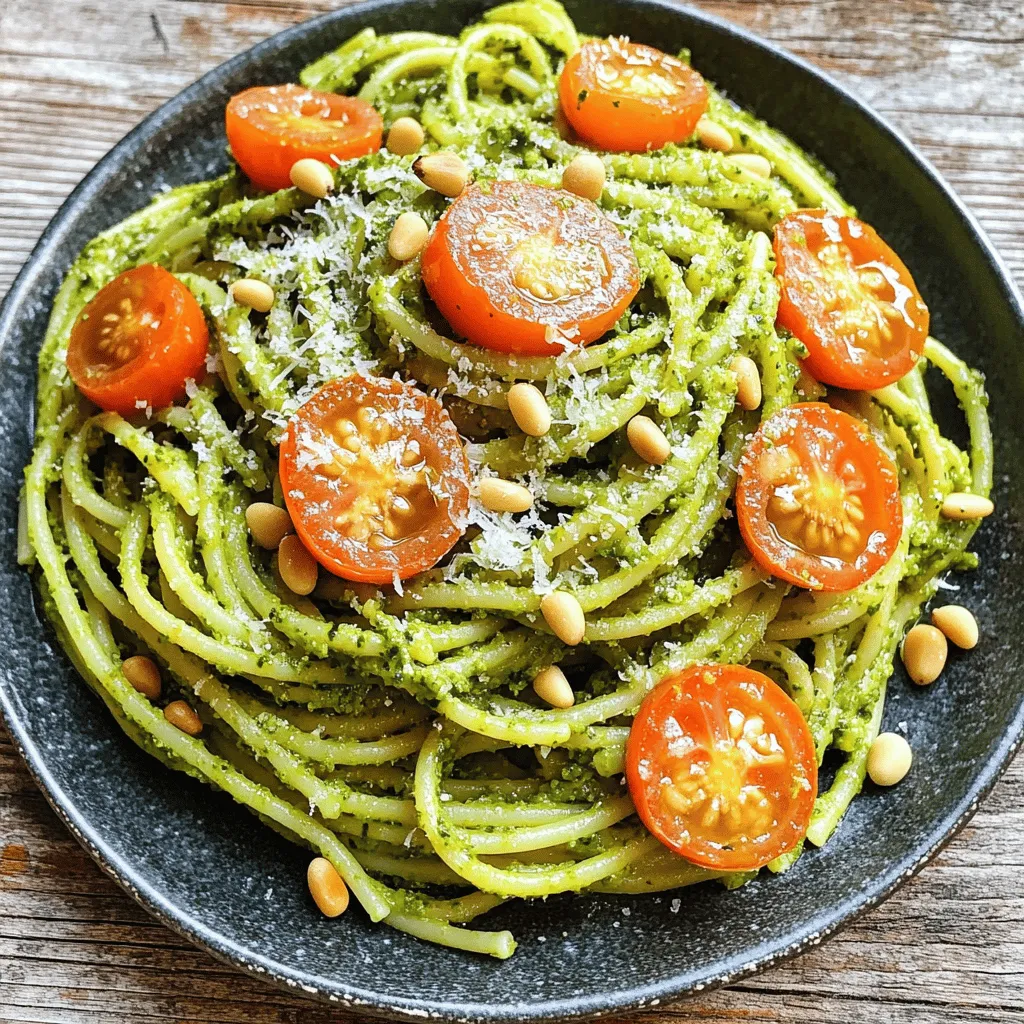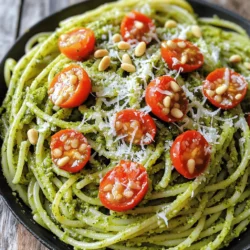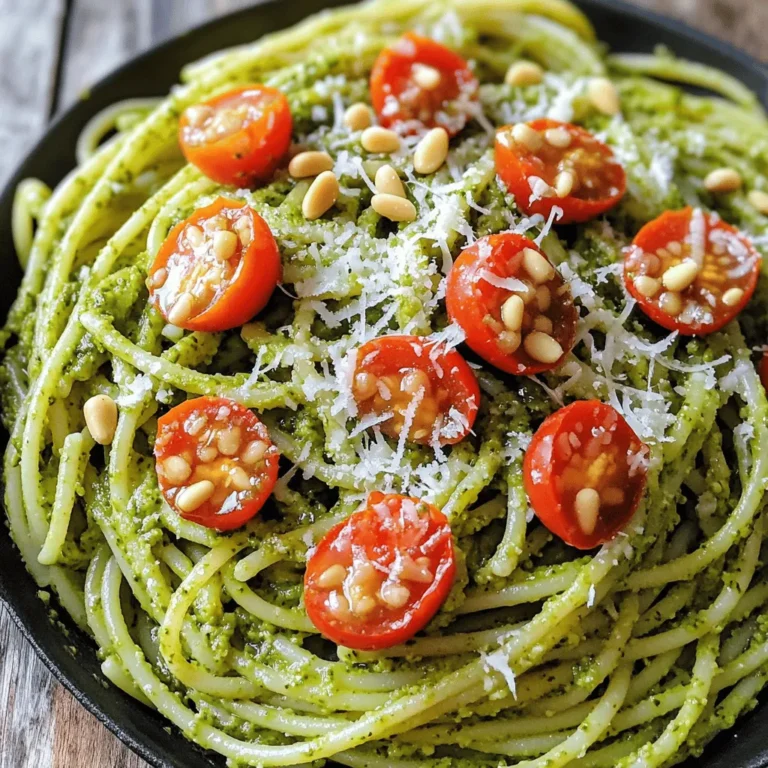If you love vibrant flavors and quick meals, you’ll adore this Classic Pesto Pasta recipe. It’s simple to make, and you can whip it up in no time. With just a few fresh ingredients, you can create a dish that bursts with taste. Let’s dive into this easy recipe that even kids can help with, making dinner both fun and delicious. Ready to cook? Let’s get started!
Ingredients
Essential Ingredients for Classic Pesto Pasta
To make the best Classic Pesto Pasta, you need some key ingredients. Here’s what you should gather:
- 2 cups fresh basil leaves
- 1/2 cup extra-virgin olive oil
- 1/3 cup pine nuts (or walnuts for a twist)
- 2 cloves garlic, minced
- 1/2 cup grated Parmesan cheese
- Salt and pepper to taste
- 12 oz spaghetti or your favorite pasta
These ingredients create a bright and fresh flavor that makes this dish special.
Optional Garnishes and Add-ins
You can add some fun touches to your pasta. Consider these garnishes and add-ins:
- 1/2 cup cherry tomatoes, halved (for garnish)
- 2 tablespoons lemon juice (for a fresh zing)
These add a pop of color and flavor that enhance your meal.
Equipment Needed for Preparation
Having the right tools makes cooking easier. Here’s what you’ll need:
- Large pot for boiling pasta
- Food processor for making pesto
- Mixing bowl for combining pasta and sauce
- Measuring cups and spoons
With these items, you can whip up your Classic Pesto Pasta quickly and easily.
Step-by-Step Instructions
Cooking the Pasta
Start by boiling a large pot of salted water. Add your pasta, like spaghetti, to the pot. Cook it according to the package instructions. You want it to be al dente, which means firm but cooked. This usually takes about 8 to 10 minutes. Once done, reserve one cup of the pasta water. Then, drain the pasta and set it aside.
Making the Pesto from Scratch
Now, let’s make the pesto! Grab a food processor and add 2 cups of fresh basil leaves, 1/3 cup of pine nuts, and 2 minced garlic cloves. Next, add 1/2 cup of grated Parmesan cheese. Pulse this mixture until it is finely chopped. With the processor running, slowly drizzle in 1/2 cup of extra-virgin olive oil. This makes the pesto creamy. Scrape down the sides if needed. Finally, add salt, pepper, and 2 tablespoons of lemon juice. Pulse a few more times to mix well. Taste it and adjust the seasoning if you want.
Combining the Pasta and Pesto Sauce
In a large mixing bowl, combine the cooked pasta with the pesto sauce. Pour in some of that reserved pasta water, a little at a time, until the pasta is well-coated. You want it to be just right, not too dry or too wet. Once mixed, serve the pasta on plates. Top each dish with halved cherry tomatoes for extra color and taste. If you like, you can sprinkle more Parmesan cheese on top. Enjoy your meal!
Tips & Tricks
Achieving the Perfect Pesto Consistency
To get the best pesto, you need the right blend. Start by using a food processor. Add basil, garlic, and nuts first. Pulse until they are finely chopped. Then, slowly drizzle in the olive oil. This method helps create a smooth texture. If it’s too thick, add a bit of the reserved pasta water. This will loosen it up and give it a silkier feel.
Storing Leftover Pesto
If you have extra pesto, store it right. Place it in an airtight container. Pour a thin layer of olive oil on top. This keeps it fresh and prevents browning. It can last in the fridge for up to a week. You can also freeze pesto in ice cube trays. This way, you can use just what you need later.
Cooking Pasta to Perfection
Cooking pasta can be simple. Use a large pot and fill it with water. Add a good amount of salt. This enhances the pasta’s flavor. Bring the water to a boil before adding the pasta. Cook according to the package instructions until it’s al dente. Remember to save some pasta water before draining. This starchy water is great for helping your pesto stick.

Variations
Substitutions for Allergies or Preferences
If you have allergies, you can swap ingredients. Use sunflower seeds instead of pine nuts. If you can’t use dairy, try a dairy-free cheese. This will keep your pesto creamy. You can also skip the cheese for a lighter taste.
Different Pasta Shapes to Use
While spaghetti is classic, other shapes work well too. Try fusilli for a fun twist. Penne holds onto the sauce nicely. You can also use gluten-free pasta if needed. Each shape gives a new texture and taste.
Adding Protein or Vegetables
Want to make your meal heartier? Add grilled chicken or shrimp. They pair well with the fresh pesto. You can also mix in veggies like spinach or peas. This boosts flavor and nutrition. Experiment with what you like best!
Storage Info
Best Practices for Storing Leftover Pasta
To keep your leftover pesto pasta fresh, store it in an airtight container. Make sure it cools down before sealing. This way, it does not steam and get soggy. You can keep it in the fridge for up to three days. Label the container with the date so you know when it was made.
Freezing Pesto for Future Use
Freezing pesto is simple and a great way to save extra sauce. Use ice cube trays to freeze small portions of pesto. Once frozen, pop them out and place them in a freezer bag. This way, you can use only what you need later. Pesto can last in the freezer for about three months. Always label your bags with the date.
Reheating Instructions for Leftover Pesto Pasta
When you want to eat your leftover pesto pasta, reheating is easy. You can use the microwave or a skillet. For the microwave, place it in a bowl and cover it with a damp paper towel. Heat in short bursts, stirring in between. If using a skillet, add a splash of water to help it heat evenly. Stir over medium heat until hot. Enjoy your delicious meal!
FAQs
What is the best type of pasta for pesto?
The best pasta for pesto is usually spaghetti. It holds the sauce well. Other great options include linguine or fusilli. These shapes catch the pesto and enhance each bite. If you want something unique, try using whole wheat or gluten-free pasta.
Can I make pesto without nuts?
Yes, you can make pesto without nuts. Simply leave them out or swap them for seeds. Sunflower seeds or pumpkin seeds work well. This keeps the flavors bright while making it safe for nut allergies.
How can I make Classic Pesto Pasta vegan?
To make Classic Pesto Pasta vegan, replace Parmesan cheese with nutritional yeast. This adds a cheesy flavor without using dairy. Use a vegan pasta too. Most pasta is made from wheat and does not contain animal products.We covered key ingredients, essential tools, and step-by-step instructions. You learned how to cook pasta perfectly and achieve the right pesto texture. We shared tips for storing leftovers and offered variations based on your needs. Remember, you can mix in proteins or veggies for a twist. Enjoy your fresh, homemade pesto pasta!


